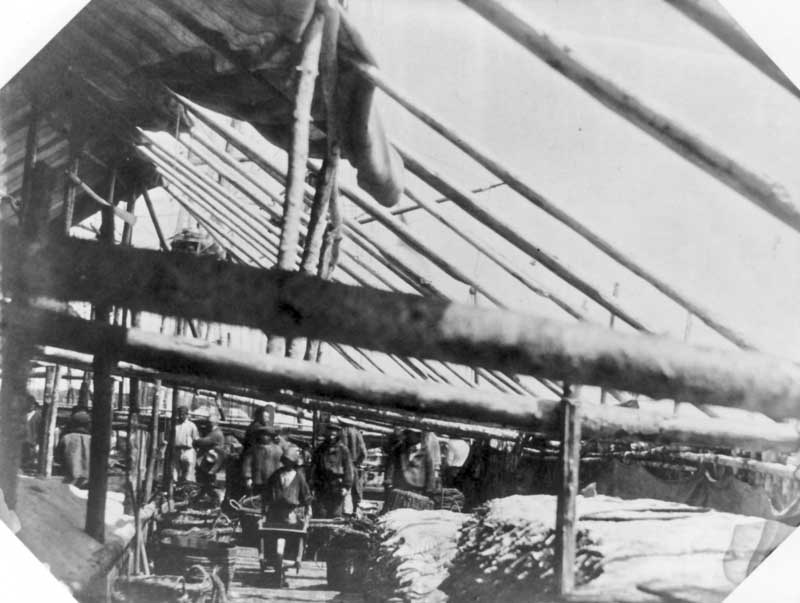![]()
Acquis avec le support financier du ministre du Patrimoine dans le cadre de la loi sur l'importation et l'exportation de biens culturels.
Acquired with the financial support of the Ministry of Heritage under the Cultural Property Export and Import Act.
![]()
"Vue intérieure d'un chauffaud." 1857 / Terre-Neuve
["Interior view of a stage."
1857 / Newfoundland.]
 |
![]()
| In his
Voyage à Terre-Neuve (Caen: Poisson, 1952, pp. 89-90)
Carpon describes the French stage as follows:
[...] the structure has nothing very complicated about it. Trunks of fir trees set close to each other and laid out horizontally form the base or the floor, and other similar trunks, set vertically, form the sides and the gabled ends, and support the peak. The front section, facing the the sea, is known as the stage head or gallery. At the edge it has a raised barrier made from more fir trunks laid lengthwise to a height of about one metre; this is to prevent the cod that is thrown on to the floor from falling back into the sea. Overhead there is a large piece of sailcloth1 that is clewed up or unfurled as desired; it is arranged both to protect the people who work in this kind of shed from the wind and the cold and to prevent the lamps from flickering when they are working at night. Back about five or six metres from the stage head are the tables for the headers and the splitters; in the central area is a walkway about one and a half metres wide through which those working at the fishery have to pass. Approximately in the middle of this large rectangular area is an enclosed space reserved for the salt. Above this, in some settlements, they put the beds of the shoremen. These are the workmen who do not go out to fish but whose job is to receive the fish and prepare it so that it is dry and properly treated ready for being loaded on board. This structure resembling a large cage has one or more entries, and is very much like the other cabins, except that, instead of planks, it is covered with a huge piece of sailcloth pulled tight with straps that are fixed in every direction to the uprights on the sides. Long poles opened up into an inverted V are placed a short distance from each other and laid over the peak; the lower ends are tied down so that the wind can have no purchase on the canvas roof. 1. In Newfoundland this is known as an "abat-vent" (wind-break); to clew up and to unfurl mean to roll up and to spread out. Translation: Michael and Frances Wilkshire |
Dans son Voyage à
Terre-Neuve (Caen: Poisson, 1952, pp. 89-90), Carpon décrit ainsi
le "chauffaud" (ou "chaufaud"):
[...] l'édifice n'offre rien de bien compliqué dans sa construction: des sapins tronçonnés, rapprochés les uns des autres et placés horizontalement, en forment la base ou plancher, et d'autres troncs semblables, posés verticalement, constituent les cotés et les pignons, et supportent le faîte. La partie antérieure, correspondant à la mer, est appelée galerie ou poissonnerie; elle est bornée par une saillie, formée d'autres corps de sapins, entassés longitudinalement à la hauteur d'un mètre, et ce, pour empêcher la morue, jetée sur le plancher, de retomber à la mer. Au-dessus est une longue toile1, que l'on cargue et largue à volonté; elle est ainsi disposée pour préserver du vent et du froid ceux qui sont au travail sous cette sorte de hangar, et empêcher la vacillation de la lumière des lampes, quand on y travaille de nuit. En arrière de la poissonnerie, et à une distance de cinq ou six mètres, sont les étaux des trancheurs; au point central, se trouve une division, large d'environ un mètre 1/2, par où l'on passe pour l'exploitation de la pêche. À peu près au centre de ce grand carré long, est un enclos destiné au sel; au-dessus de cette pièce, sont placés, dans certaines habitations, les lits des chaufaudiers ou gens de travail n'allant pas en pêche, mais dont le soin est de recevoir le poisson, et de le mettre en état d'être embarqué bien sec et bien conditionné. Cette espèce de grande cage a une ou plusieurs entrées, et ressemble beaucoup aux autres cabanes, sauf qu'au lieu d'être couverte en planches, elle l'est d'une vaste toile, tendue de force avec des courroies, fixées sur tous sens aux montants des côtés. De longues gaules ouvertes en V renversé, placées à peu de distance les unes des autres, et enfourchées sur le faîtage, sont saisies à leur extrémité inférieure, de manière à ce que le vent ne puisse avoir aucune prise sur cette tente. 1. À Terre-Neuve, elle porte le nom d'abat-vent; carguer et larguer signifient rouler et dérouler. |
![]()